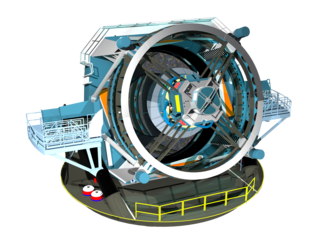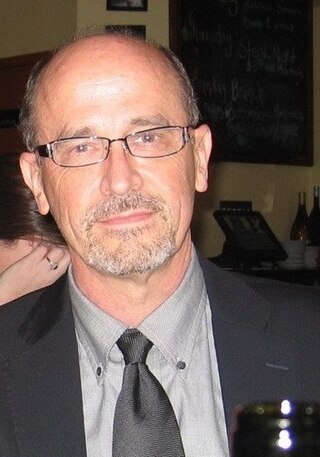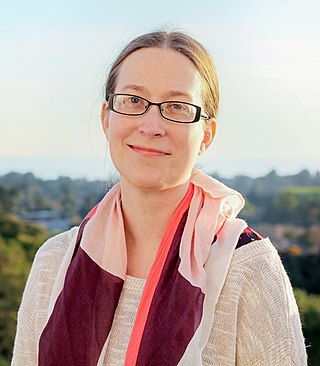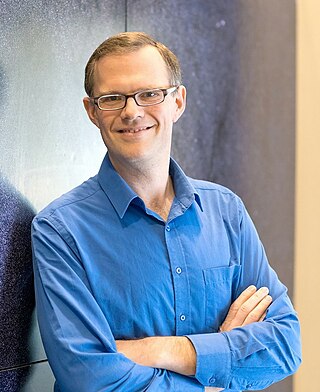In astronomy, dark matter is a hypothetical form of matter that appears not to interact with light or the electromagnetic field. Dark matter is implied by gravitational effects which cannot be explained by general relativity unless more matter is present than can be seen. Such effects occur in the context of formation and evolution of galaxies, gravitational lensing, the observable universe's current structure, mass position in galactic collisions, the motion of galaxies within galaxy clusters, and cosmic microwave background anisotropies.

Saul Perlmutter is a U.S. astrophysicist, a professor of physics at the University of California, Berkeley, where he holds the Franklin W. and Karen Weber Dabby Chair, and head of the International Supernova Cosmology Project at the Lawrence Berkeley National Laboratory. He is a member of both the American Academy of Arts & Sciences and the American Philosophical Society, and was elected a Fellow of the American Association for the Advancement of Science in 2003. He is also a member of the National Academy of Sciences. Perlmutter shared the 2006 Shaw Prize in Astronomy, the 2011 Nobel Prize in Physics, and the 2015 Breakthrough Prize in Fundamental Physics with Brian P. Schmidt and Adam Riess for providing evidence that the expansion of the universe is accelerating. Since 2021, he has been a member of the President’s Council of Advisors on Science and Technology (PCAST).

Robert P. Kirshner is an American astronomer, Chief Program Officer for Science for the Gordon and Betty Moore Foundation, and the Clownes Research Professor of Science at Harvard University. Kirshner has worked in several areas of astronomy including the physics of supernovae, supernova remnants, the large-scale structure of the cosmos, and the use of supernovae to measure the expansion of the universe.
The Supernova Cosmology Project is one of two research teams that determined the likelihood of an accelerating universe and therefore a positive cosmological constant, using data from the redshift of Type Ia supernovae. The project is headed by Saul Perlmutter at Lawrence Berkeley National Laboratory, with members from Australia, Chile, France, Portugal, Spain, Sweden, the United Kingdom, and the United States.

The Vera C. Rubin Observatory, previously referred to as the Large Synoptic Survey Telescope (LSST), is an astronomical observatory currently under construction in Chile. Its main task will be carrying out a synoptic astronomical survey, the Legacy Survey of Space and Time. The word synoptic is derived from the Greek words σύν and ὄψις, and describes observations that give a broad view of a subject at a particular time. The observatory is located on the El Peñón peak of Cerro Pachón, a 2,682-meter-high mountain in Coquimbo Region, in northern Chile, alongside the existing Gemini South and Southern Astrophysical Research Telescopes. The LSST Base Facility is located about 100 kilometres (62 mi) away from the observatory by road, in the town of La Serena. The observatory is named for Vera Rubin, an American astronomer who pioneered discoveries about galaxy rotation rates.

Alexei Vladimir "Alex" Filippenko is an American astrophysicist and professor of astronomy at the University of California, Berkeley. Filippenko graduated from Dos Pueblos High School in Goleta, California. He received a Bachelor of Arts in physics from the University of California, Santa Barbara in 1979 and a Ph.D. in astronomy from the California Institute of Technology in 1984, where he was a Hertz Foundation Fellow. He was a postdoctoral Miller Fellow at Berkeley from 1984 to 1986 and was appointed to Berkeley's faculty in 1986. In 1996 and 2005, he a Miller Research Professor, and he is currently a Senior Miller Fellow. His research focuses on supernovae and active galaxies at optical, ultraviolet, and near-infrared wavelengths, as well as on black holes, gamma-ray bursts, and the expansion of the Universe.
The High-Z Supernova Search Team was an international cosmology collaboration which used Type Ia supernovae to chart the expansion of the universe. The team was formed in 1994 by Brian P. Schmidt, then a post-doctoral research associate at Harvard University, and Nicholas B. Suntzeff, a staff astronomer at the Cerro Tololo Inter-American Observatory (CTIO) in Chile. The original team first proposed for the research on September 29, 1994, in a proposal called A Pilot Project to Search for Distant Type Ia Supernova to the CTIO. The original team as co-listed on the first observing proposal was: Nicholas Suntzeff (PI); Brian Schmidt (Co-I); R. Chris Smith, Robert Schommer, Mark M. Phillips, Mario Hamuy, Roberto Aviles, Jose Maza, Adam Riess, Robert Kirshner, Jason Spiromilio, and Bruno Leibundgut. The original project was awarded four nights of telescope time on the CTIO Víctor M. Blanco Telescope on the nights of February 25, 1995, and March 6, 24, and 29, 1995. The pilot project led to the discovery of supernova SN1995Y. In 1995, the HZT elected Brian P. Schmidt of the Mount Stromlo Observatory which is part of the Australian National University to manage the team.

Adam Guy Riess is an American astrophysicist and Bloomberg Distinguished Professor at Johns Hopkins University and the Space Telescope Science Institute. He is known for his research in using supernovae as cosmological probes. Riess shared both the 2006 Shaw Prize in Astronomy and the 2011 Nobel Prize in Physics with Saul Perlmutter and Brian P. Schmidt for providing evidence that the expansion of the universe is accelerating.
The Gruber Prize in Cosmology, established in 2000, is one of three prestigious international awards worth US$500,000 awarded by the Gruber Foundation, a non-profit organization based at Yale University in New Haven, Connecticut.

Cornelis A. "Neil" Gehrels was an American astrophysicist specializing in the field of gamma-ray astronomy. He was Chief of the Astroparticle Physics Laboratory at NASA's Goddard Space Flight Center (GSFC) from 1995 until his death, and was best known for his work developing the field from early balloon instruments to today's space observatories such as the NASA Swift mission, for which he was the principal investigator. He was leading the WFIRST wide-field infrared telescope forward toward a launch in the mid-2020s. He was a member of the National Academy of Sciences and the American Academy of Arts and Sciences.

Nicholas B. Suntzeff is an American astronomer and cosmologist. He is a University Distinguished Professor and holds the Mitchell/Heep/Munnerlyn Chair of Observational Astronomy in the Department of Physics & Astronomy at Texas A&M University where he is Director of the Astronomy Program. He is an observational astronomer specializing in cosmology, supernovae, stellar populations, and astronomical instrumentation. With Brian Schmidt he founded the High-z Supernova Search Team, which was honored with the Nobel Prize in Physics in 2011 to Schmidt and Adam Riess.
In physical cosmology and astronomy, dark energy is an unknown form of energy that affects the universe on the largest scales. Its primary effect is to drive the accelerating expansion of the universe. Assuming that the lambda-CDM model of cosmology is correct, dark energy is the dominant component of the universe, contributing 68% of the total energy in the present-day observable universe while dark matter and ordinary (baryonic) matter contribute 26% and 5%, respectively, and other components such as neutrinos and photons are nearly negligible. Dark energy's density is very low: 6×10−10 J/m3, much less than the density of ordinary matter or dark matter within galaxies. However, it dominates the universe's mass–energy content because it is uniform across space.

The Calán/Tololo Supernova Survey was a supernova survey that ran from 1989 to 1995 at the University of Chile and the Cerro Tololo Inter-American Observatory to measure a Hubble diagram out to redshifts of 0.1. It was founded by Mario Hamuy, José Maza Sancho, Mark M. Phillips, and Nicholas B. Suntzeff in 1989 out of discussions at the UC Santa Cruz meeting on supernovae on how to improve the Hubble diagram using Type Ia supernovae. It was also motivated by the suggestion of Allan Sandage to restart a supernova survey after the Sandage and Tammann survey failed due to poor quality photographic plates in 1986. The Survey built on the original supernova survey of Maza done at the f/3 Maksutov Camera at the Cerro Roble Observatory of the University of Chile between 1979 and 1984. The Survey used the CTIO Curtis Schmidt telescope with IIa-O photographic plates, each plate covering a field of 25 sq-deg on the sky. The plates were developed and sent to Santiago Chile the next morning and searched for supernovae at the Department of Astronomy at the University of Chile. Any supernova candidates were then observed the next night using the 0.9m telescope at CTIO with a CCD camera. This was one of the first studies done in astronomy where the telescope time was scheduled to observe objects not yet discovered.

Beth Willman is an American astronomer who is the Chief Executive Officer of the LSST Discovery Alliance, an astronomical organization notable for its support of the Vera C. Rubin Observatory. She was previously the deputy director of the National Optical-Infrared Astronomy Research Laboratory (NOIRLab) and an associate professor of astronomy at Haverford College.

Warrick John Couch is an Australian professional astronomer. He is currently a professor at Swinburne University of Technology in Melbourne. He was previously the Director of Australia's largest optical observatory, the Australian Astronomical Observatory (AAO). He was also the president of the Australian Institute of Physics (2015–2017), and a non-executive director on the Board of the Giant Magellan Telescope Organization. He was a founding non-executive director of Astronomy Australia Limited.
Rachel Mandelbaum is a professor of astrophysics at Carnegie Mellon University, studying cosmology and galactic evolution with a focus on dark matter and dark energy. Much of her work has used the phenomenon of gravitational lensing of galaxies and she has made significant improvements in the calibration of lensing parameters.
Rachel Bean is a cosmologist and theoretical astrophysicist. She is a professor of astronomy and the interim dean of the Cornell University College of Arts and Sciences.

Peter Lawrence Capak is currently the Architect of Perception Systems at the Oculus division of Facebook. His current focus is developing machine perception technologies, sensors, displays, and compute architectures for the next generation of augmented (AR), mixed (MR) and virtual reality (VR) systems. His research has focused on using physical modeling and advanced statistical methods including artificial intelligence and machine learning to extract information from very large multi-wavelength (hyper-spectral) data sets. He has primarily used this to study structure formation in the universe, cosmology, and the nature of dark matter and dark energy.
Mustapha Ishak-Boushaki is a theoretical physicist, cosmologist and professor at the University of Texas at Dallas. He is known for his contributions to the studies of cosmic acceleration and dark energy, gravitational lensing, and testing alternatives to general relativity; as well as his authorship of Testing General Relativity in Cosmology, a review article published in Living Reviews in Relativity. He was elected as a fellow of the American Association for the Advancement of Science (AAAS) in 2021 and as a fellow of the American Physical Society (APS) with the quote: "For distinguished contributions to the field of theoretical cosmology, particularly for testing modifications to general relativity at cosmological scales, and for sustained excellence in teaching and mentoring of students."
Anna Elisabeth Krause is a German-American astronomer and assistant professor of physics at the University of Arizona.











